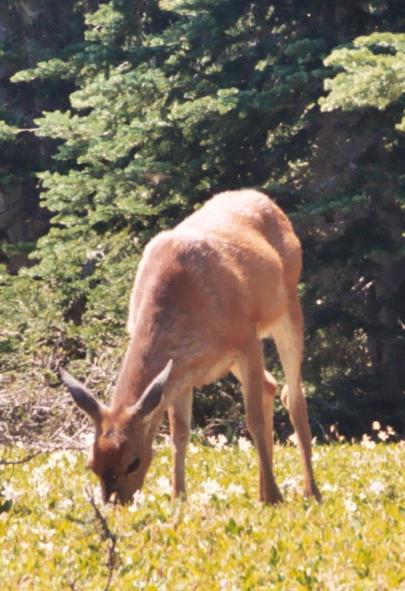
Nutrition
Most of there diet consists of woody
herbaceous forage. According to Anderson and Wellmo (1984) the deer
were thought to be browsers but do to physiology that is not the
case. The Columbian Black Tail Deer are actually intermediate
feeders because do to their short height. The Black Tailed Deer’s
diet mainly consists of brome, orchard, blue grass, and woody
shrubbery (Millburn 2011). They also like to eat lichens, mushrooms,
and some times berries (Millburn 2011). For the main part they often
eat at dawn and at night, and when they do they are usually around
some type of shrubbery (Millburn 2011). The Black Tailed Deer uses
it mainly to feed and it gives the deer a sense of protection (Millburn 2011).
Winter Feeding
When winter comes it is obvious that there is very little food for
the most part so what the mule deer in general like to feed on is
bitterbrush (Blecich et al. 2004). They take on this alternative diet because in the winter they
either have to dig in the snow for grass or they eat the bitterbush.
The brush has a high content of moisture and nutrients, compared to
that of the other plants in the winter. Mostly what were measured
were the moisture levels (1.07%), nitrogen levels (1.97%), and the
percent level of abundance (27.95%). The plants can be found wit h
constant levels in almost all of the places that it could be found
(Blecich et al. 2004). Also in lesser quantities the deer have also
been known to eat rabbitbrush, blackbrush, grass, and other
respectively in that order but in much less quantities compared to
that of the bitterbrush (Blecich et al. 2004). When it comes to
feeding the mule deer in general spend about 40-60% of their time
feeding and consuming food (Hanley ect. All 2004). In mule deer
there was a study done to measure out the amounts of bite they would
take according to how moist the matter was and it sees as the
moisture there is the more bites (Hanley ect. All 2004). What this
means is that when it snows the food level is low like stated before
but the ideal time to feed the best would be in the spring.
2004). They take on this alternative diet because in the winter they
either have to dig in the snow for grass or they eat the bitterbush.
The brush has a high content of moisture and nutrients, compared to
that of the other plants in the winter. Mostly what were measured
were the moisture levels (1.07%), nitrogen levels (1.97%), and the
percent level of abundance (27.95%). The plants can be found wit h
constant levels in almost all of the places that it could be found
(Blecich et al. 2004). Also in lesser quantities the deer have also
been known to eat rabbitbrush, blackbrush, grass, and other
respectively in that order but in much less quantities compared to
that of the bitterbrush (Blecich et al. 2004). When it comes to
feeding the mule deer in general spend about 40-60% of their time
feeding and consuming food (Hanley ect. All 2004). In mule deer
there was a study done to measure out the amounts of bite they would
take according to how moist the matter was and it sees as the
moisture there is the more bites (Hanley ect. All 2004). What this
means is that when it snows the food level is low like stated before
but the ideal time to feed the best would be in the spring.
Go to
MultipleOrganisms.net